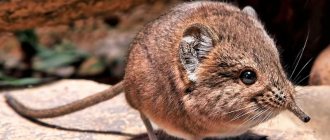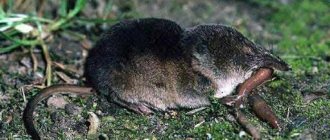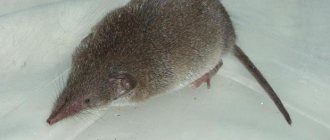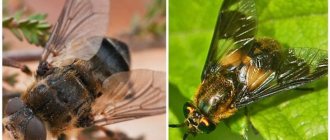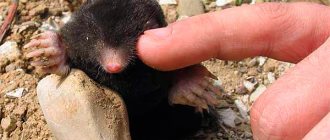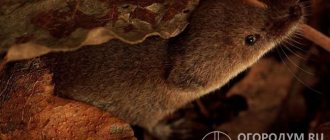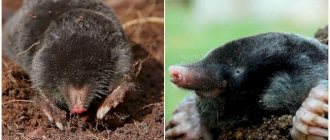The appearance of the animals is direct evidence
You can distinguish a mole from a shrew by appearance, but the difficulty is that they practically do not crawl out of their holes, live underground or appear at night. Moles and shrews go outside during the mating season - April, May, and also after 2 months of their life to build a new hole and search for a suitable place.
- Description of the mole. A rodent with a body weight of no more than 120 g, about 20 cm long. It has short, thick, soft fur of a shiny black color. A small tail no more than 4 cm. The muzzle is oblong, the nose is clearly visible. The eyes are small, round, and the ears are covered with skin. A distinctive feature is the wide front paws with long claws. This “equipment” allows the animals to easily dig the ground and build numerous passages in depth and width. With their hind limbs, animals throw away the soil, throw them out of the hole, and form mounds of molehills.
- Description of the shrew. The rodent looks like a small mouse. Body length no more than 20 cm. Short, soft, velvety, fluffy gray wool. Unlike a mouse, it does not have pronounced ears; its muzzle is significantly extended forward. It differs from the mole in the absence of spade-shaped limbs, a long tail about 12 cm. The eyes are small, barely noticeable, the abdomen and paws are light.
A photo of a mole and a shrew is presented below. If you manage to catch or see an animal on your property, you can accurately determine who is who.
The Mole and the Shrew
Domestic cats often hunt shrews and moles. They skillfully catch prey, but are in no hurry to eat it. A hungry cat can chew up a mole, but will leave a shrew to its competitors without much regret. A specific mouse secretes a special enzyme with a strong unpleasant odor that repels predators. Only owls, ferrets, weasels, and foxes do not disdain.
The structure of the hole - indirect evidence
Animals lead a hidden lifestyle; it is very difficult to notice them on the surface of the earth. The presence of pests is determined by mounds above the ground.
Moles dig numerous passages up to 2 m deep, 4 m wide or more. The animal plows up to 45 m of soil per day. The upper passages are intended for hunting. In labyrinths, animals look for beetles, earthworms, snails, caterpillars, and May beetle larvae. Less commonly, moles feed on roots, roots, seeds, as well as small mice, snakes, lizards, and frogs.
Mole and shrew burrows
You can distinguish a mole's hole from a shrew's hole by the large mounds of loosened soil above the surface of the ground. The number of pests is determined by the number of such tubercles. They appear more often in the garden, where the soil is moist and there is shade from trees. In early spring, you can notice traces of vital activity in the garden.
The shrew builds labyrinths underground with several entrances and exits, but does not leave bumps on the surface. A distinctive feature is the holes in the ground - deep holes. Often the animal simply occupies ready-made labyrinths, previously built by rats, mice, hamsters, and moles.
Shrews and moles are insectivorous animals and do more good than harm (although land owners are fighting them), which cannot be said about their relative, the mole rat. This underground resident is constantly underground, feeds on plant foods, and looks like a miniature beaver thanks to its large, long teeth.
Information about these underground inhabitants is often contradictory, since their way of life is not fully understood and has many blank spots. The most incredible rumors and “heartbreaking” stories are being spread about the benefits and harms of these funny animals, especially among summer residents, more like fiction and fantasies, since shrews and moles are blamed for all imaginable and unimaginable misadventures of gardeners, blaming almost all of the poor animals “ dogs."
So, how to distinguish a mole from a shrew, what is the difference between them and in fact, these little animals are so dangerous and harmful. Let's figure it out.
Few people have seen this animal in person, since it lives underground. The shrew looks like a mouse, but has a more elongated muzzle with an elongated proboscis. Her fur is soft, fluffy, velvety, gray in color. The ears on the head are practically absent, and the eyes are very small and blind.
The shrew reaches eighteen to twenty centimeters in length and has a very long tail. The baby's weight is no more than fifteen grams.
Predatory animals such as foxes, dogs and domestic cats sometimes catch and strangle shrews, mistaking them for mice, but do not eat them, because thanks to the musk gland, the animal emits a strong unpleasant odor, which discourages its pursuers from any appetite. Only some species of birds of prey do not have an aversion to shrews, such as owls and small wild animals like ferrets and weasels, for which the unpleasant spirit emanating from the animal is not a hindrance.
Like all of its close relatives, such as hedgehogs and moles, the shrew belongs to the order of insectivores and, like most rodents, lives in burrows, feeding mainly on animal food. Scouring the ground in search of food and using passages left by mice and other rodents, shrews devour insects, worms, larvae, and other small animals.
Since the shrew has a powerful metabolism and cannot go without food for a long time (no more than seven to nine hours at a time), it has to constantly get food and eat more food during the day than it weighs.
The most common are the two types of shrews:
· Shrews (lat. Crocidura)
· Shrews (lat. Sorex)
As the names of the animals suggest, some have white tips of their teeth, while others have brown tips. In addition, shrews are usually much smaller in size.
Since the shrew is a predator, it is beneficial by destroying the larvae of harmful insects living underground. In addition, these animals excellently loosen the soil, saturating it with oxygen and thus aerating the soil.
Notes[edit | edit code]
- ↑ Dzerzhinsky F. Ya., Vasiliev B. D., Malakhov V. V.
Zoology of vertebrates. 2nd ed. - M.: Publishing house. , 2014. - 464 p. — ISBN 978-5-4468-0459-7. — P. 420. - ↑ Diversity of mammals / O. L. Rossolimo, I. Ya. Pavlinov, S. V. Kruskop, A. A. Lisovsky, N. N. Spasskaya, A. V. Borisenko, A. A. Panyutina. - M.: KMK Publishing House, 2004. - Part I. - 366 p. — (Diversity of animals). — ISBN 5-87317-098-3. — P. 212-213.
- ↑ Zaitsev M.V., Voyta L.L., Sheftel B.I.
Mammals of the fauna of Russia and adjacent territories. Insectivores. - St. Petersburg: Nauka, 2014. - 391 p. — (Key guides to the fauna of Russia, published by the Zoological Institute of the Russian Academy of Sciences. Issue 178). — ISBN 978-5-02-038380-7. — P. 15. - ↑ Gerd Grun.
Neomys fodiens
(undefined)
.
mammalia.gruenverlag.de
. Wasserspitzmaus (2016). - ↑ Rainer Hutterer, Danilo S. Balete, Thomas C. Giarla, Lawrence R. Heaney, Jacob A. Esselstyn.
A new genus and species of shrew (Mammalia: Soricidae) from Palawan Island, Philippines (English) // Journal of Mammalogy[en]. — 2018. — Vol. 99, iss. 3. - P. 518-536. — ISSN 0022-2372. - doi:10.1093/jmammal/gyy041.
Who are shrews
Shrews are one of the smallest rodents. They are very secretive, and farmers may not know them for a long time if these animals have settled near vegetable gardens or orchards. Since they look like mice in appearance, for some time gardeners will mistake them for ordinary rodents that harm the harvest and carry diseases. However, these mammals have a number of their own characteristics. Their muzzle is elongated and very similar to a small proboscis, their body is round, covered with thick soft fur.
Latest articles about gardening
Shrews have small eyes. It should be noted that these rodents have a special musk gland, which secretes a secretion with a strong unpleasant odor. This scent serves as a defense mechanism to ward off predators. Cats love to hunt these animals. However, once they catch a shrew, they will not eat it due to the strong smell of fermentation.
The shrew is a mammal that feeds on insects, and it can be considered a distant “relative” of the hedgehog. Like moles, these animals live in underground burrows. What suits them best are other people's burrows, those dug by other animals. Shrews are capable of leading a very active lifestyle, being awake 24 hours a day. Since they have an active metabolism in their body, they have to eat regularly to enrich it with the required amount of calories. They cannot go without food for more than 8-9 hours. For this reason, they have to constantly search for food by hunting insects. They need to get a lot of energy per day, so it is advisable for them to eat as much food as they weigh. Shrews mostly hunt on their own, and can eat smaller rodents, beetles, various parasite larvae, and the like.
The most common are the two types of shrews:
- Shrews (lat. Croc >As the name of the animals suggests, some have white tooth tips, while others have brown tips. In addition, shrews are usually much smaller in size.
Reproduction[edit | edit code]
Shrews breed 1-2, less than 3 times a year. Pregnancy lasts 13-28 days. There are 4-14 cubs in a litter. They are born naked, blind, with an undeveloped proboscis (snub-nosed), but they develop very quickly and become independent at 4 weeks of age. In shrews, mother and offspring move in a chain or “caravan”, holding each other’s tails with their teeth. An amazing ability has been discovered in young shrews, called the “Denel phenomenon.” In autumn, they experience a decrease in body size and flattening of the skull. Then from April to June there is an increase in the volume of the skull, an increase in the mass and volume of the brain.
The maximum lifespan of shrews is 18 months.
Where do shrews live?
It is noteworthy that severe hunger can turn an insectivorous mammal into a real predator. In the fight for prey, a shrew can fight with its fellow tribesmen, mice or lizards.
Where does the shrew live? In forests, on the banks of reservoirs, in meadows, in foliage and last year's grass. She especially loves secluded tree crevices or rotten hollows, where she can sleep sweetly during the day.
Basically, this insectivore prefers to “work” at night. Geographically, the shrew lives all over the globe, with the exception of the polar regions, where the cold reigns - there it can be found very rarely. But in fact, this animal is not afraid of either heat or cold.
MUSKRAT
What does the word MUSHROOM
in dictionaries:
- Question: An animal that looks like a mole - answer: muskrat
- What animal living in water has a trunk?
- A mole with a small proboscis
- A mole with a proboscis
- Large representative of the order Insectivores
- Musk mole rhymes with tumor
- Musky relative of the mole
- Insectivorous mammal
- Fur animal
- A relative of the mole living in Russia
Animal of the mustelid family
French movie star who was terrified not only of fire, but also of electricity
Harm and benefits of shrews
Shrews are characterized by a very fast metabolism, so the animal is constantly in search of food and is active around the clock. The shrew can be safely called a fairly ferocious predator that feeds on various insects and their larvae. In the garden in a day, it destroys a number of pests several times greater than its own weight.
It would be worth recognizing this animal as useful if the shrew did not dig a huge number of underground passages in search of food. In search of larvae, the animal gnaws all the roots and root crops that it encounters along its route. In a matter of days, a smooth green lawn can turn into piles of earth and hummocks. Although it is worth noting that moves improve soil aeration if something is left to grow on it.
In most cases, control of the shrew is necessary. Damaged lawns and destroyed crops negate all the benefits that the animal brings.
Medvedka
The mole cricket is a large insect whose body length can reach 5 centimeters. The visual differences will be as follows:
- the size of the abdomen is 3 times larger than the cephalothorax;
- the abdomen may be soft in structure and may have a fusiform shape;
- diameter – 1 centimeter;
- At the end of the abdomen, paired thin thread-like appendages are visible.
The insect is primarily inclined towards an underground lifestyle. Despite this, it is capable of flying well, running on the ground and even swimming. The insect almost never gets to the surface of the earth. Even if a mole cricket gets to the surface, it happens in the dark.
How to deal with shrews
People go to various lengths to drive this voracious guest out of their area. Some methods are quite original and, at first glance, raise doubts about their effectiveness. However, it is not for nothing that gardeners advise each other certain techniques that have been known for decades. As practice shows, they really work; I’ll give a few examples here.
Methods to combat shrews:
- As mentioned above, this animal has an enviable sense of smell. If you find an animal's burrow, try to bury fish heads or entrails that were removed when cleaning the fish right there (during the move). After a short time, the smell of decomposition will drive the shrew out of the area. This method is also good in the fight against moles and mole rats.
- If you have a vigilant cat, then he can also become a good assistant in the fight against pests. The small animal really looks like a mouse and will cause a completely expected reaction in a hunting cat. According to reviews from summer residents, cats cope well with this mission, although they do not eat the prey afterwards. The reason for this is the characteristic odor released by the musk glands of the shrew.
- Water from a hose, which is poured into the detected pest passages. Sometimes quite a few liters of water may be needed, but this is an old proven method that allows you to “pour” a shrew out of its shelter.
Latest articles about gardening
Digger Mikhail Savkin.
“We discovered a concentration of ducks on one of the islands of silt, which is located underground. They were without any feathers. That is, they were completely bald and had red eyes. It was clear that the ducks had already adapted to this environment.”
The diggers are confident that what they managed to see in their travels underground is just the tip of the iceberg. In the deeper layers of the earth there are larger inhabitants. There is a whole world of creepy creatures underground. Sometimes they manage to break through and escape, for example into a sewer. Diggers don’t want anyone to meet such a monster.
Who are moles
The mole (lat. Talpa europaea) is a close relative of the shrew. It has powerful front paws, well adapted for digging the ground, a muzzle with a maneuverable trunk and a short tail. The animal reaches twenty centimeters in length.
Moles live mainly underground, where they build a complex system of passages. They love moist soil, so they can settle in lowlands, in damp garden areas, or in the vegetable garden.
The mole loves to snack on earthworms, but he is also a big fan of dart beetles and beetle larvae (May beetles, etc.). So, in fact, it is difficult to call this animal a pest, rather a helper.
Reasons for appearing on a summer cottage
Reasons for the appearance of moles in dachas and garden plots:
- loose, fertilized, moist soil;
- the presence of a variety of food - larvae, worms, insects, etc. (where there are many plants, there are many different pests);
- safety of the territory (this is where moles feel calm and comfortable, because there are no sworn enemies nearby - forest predators, and they are not afraid of dogs and cats, moles easily scare them off with their specific smell).
The reasons for the appearance of shrews are very similar to those of moles, especially since, as mentioned earlier, they like to move through ready-made labyrinths.
You can scare away a mole with sound
How to recognize a mole or mole rat
And now let’s talk about the sore point, about such a complex and difficult fight against “moles”, namely mole rats, since it is not the mole, for which a plant-based diet is contraindicated, that rules our gardens, but the mole rat. The real mole, his appearance, habits and habits were discussed above. The mole rat is similar to the mole only in its manner of throwing out soil when digging holes and its exclusively underground lifestyle. You can see him extremely rarely; he leaves his underground galleries once, leaving his native nest at a young age.
The appearance of the mole rat is very unusual, the body shape resembles a plump cylinder, the geometric perfection of which is not disturbed by either the ears or the tail, since they are underdeveloped. The large head of the mole rat is flattened in the shape of a wedge. He is completely blind, in place of his eyes a thick fold of skin has formed, densely covered with bristly hair, even the fleas living on him are also blind. The body of the animal is covered with thick silky ocher-brown fur, in which there is no down and guard hairs that are familiar to us; Hard hairs protruding from the fur are organs of touch. The mole rat's legs are short and weak; they do not take part in digging; the main digging tool is huge incisors sticking out. The lips are equipped with folds that close the mouth so that the earth does not get there during underground robots. The body length of the mole rat is 20-25 cm.
In the wild, mole rats feed on all kinds of green and underground parts of plants; on occasion, they eat sown acorns, seedlings and young seedlings of oak, maple and other deciduous trees; an important part of their diet consists of bulbous trees. In a cultivated landscape, they are most numerous in crops of perennial grasses and vegetable gardens, where they subsist on root crops, bulbs, and tubers. The lifestyle of these animals is still poorly understood and still leaves many questions.
Harm and benefits of moles
It’s just that moles cannot be classified as dangerous garden pests. By digging passages and holes not too deep, the mole's paws destroy the root systems, which simply leads to the death of plants. The reason that brought the parasite to the summer cottage is considered a noble attempt to help.
Latest articles about gardening
Animals simply prefer well-moistened chernozem soils rich in insects. Their favorite food is simple earthworms, but garden pests - insect larvae, mole crickets, mice, beetles - are also a frequent food in their diet.
Like all insectivores, earth diggers have an active metabolism; the normal amount of food eaten per day is approximately equal to the weight of the rodent itself.
Simply getting rid of insects that harm plantings is not the only useful property of earth diggers. Molehills are also useful - molehills contribute to aeration (air saturation) of the earth, and constant movement underground simply improves the quality of the soil, like a special machine for loosening the soil.
Despite the advantages of living next to moles, it is necessary to get rid of them at your dacha if you have planted a vegetable garden there.
Methods of fighting moles
Moles have very poor eyesight, everyone knows this. But the sense of touch and smell is excellent. This is where most repellent methods benefit. They are divided into two groups: odorous and vibration-sound. Used in combination, they cope well with the task, but have their drawbacks. The former can drive not only moles from the site, but also the owners. For the latter, you can get hit in the neck by particularly nervous and irritable neighbors. Keep this in mind and don't overdo it.
- Rotten fish. They buy a kilogram of the cheapest sprat and leave it in the sun for a week. Then the fish are laid out in passages and holes. According to reviews, moles do not like such a stench, they leave the garden. The smell of fish attracts cats and dogs. The first ones will not do much harm to the plantings. But the latter will easily dig such pits in search of prey - any mole will hang himself with envy. By the way, the aroma from rotten flesh can reach your nostrils, so don’t be fanatical.
- Kerosene, turpentine or gasoline. Some sources recommend pouring liquid into water and watering the beds with the resulting mixture. It is doubtful that the surface stench will deter the underground inhabitants. Yes, and it’s difficult to thoroughly mix water with kerosene; it tends to float up. It will be much more effective to place rags soaked in gasoline along the passages and holes. You can use unnecessary rags or cotton pads. Don't forget about fire safety. Carefully fill up the areas where you interfere, otherwise the stench will scare you away, not the moles.
- Castor or eucalyptus oil. It is also recommended to add it to water and water the soil. In our opinion, any strong odors from above are pointless. Wet rags or cotton wool, then push them underground, right into the holes. Just not deeper than 20 cm, moles do not crawl lower. Perhaps there is only one thing - high cost. But material costs significantly reduce psychological costs after seeing molehills in the garden.
- Plants. Some bulbous plants emit an aroma that is very unpleasant for moles. These include all types of hazel grouse, daffodils, garlic, and onions. They need to be planted around the perimeter of the garden, then the diggers will pass by. Or planted over the entire area of the site, preferably in a checkerboard pattern. Moles stumble upon an odorous barrier and leave. You will have to plant it quite tightly, because nothing prevents the mole from simply changing the direction of the tunnel, having stumbled upon the bulb. In addition, flower bulbs are now expensive, especially for hazel grouse.
- Beans. Many reviews say that planting the most common black beans in garden beds is a good repellent for moles. We don’t know the mechanism of action (maybe there’s a smell?), but the method works. It is advisable to plant beans around the garden. Most often, avid summer residents use traditional methods: Crushed garlic - the sharp and unpleasant smell is repellent, and garlic has bactericidal properties. Lining the hole with herring, rotten eggs, and whey is a very effective method.
In order to understand how to drive a mole or shrew away from a site, you need to know how they live, what they eat, and why they liked your site. It is worth noting that they choose a place to live only on well-fertilized soil, rich in minerals. Therefore, the presence of moles and shrews means that you have a high-quality plot of land.
- Author: Maria Sukhorukikh
Rate this article:
- 5
- 4
- 3
- 2
- 1
(0 votes, average: 0 out of 5)
Share with your friends!
